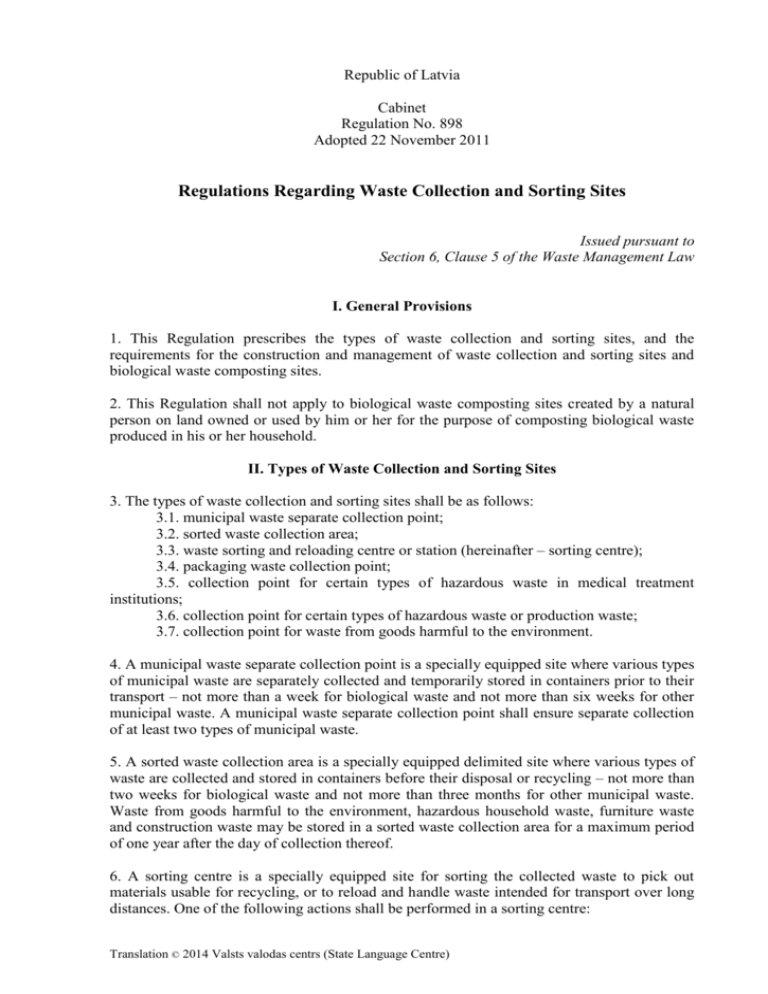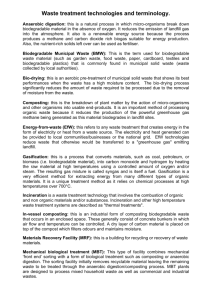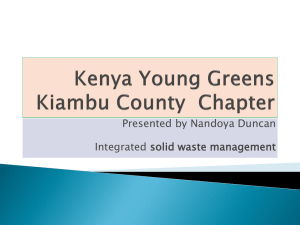Republic of Latvia Cabinet Regulation No. 898 Adopted 22
advertisement

Republic of Latvia Cabinet Regulation No. 898 Adopted 22 November 2011 Regulations Regarding Waste Collection and Sorting Sites Issued pursuant to Section 6, Clause 5 of the Waste Management Law I. General Provisions 1. This Regulation prescribes the types of waste collection and sorting sites, and the requirements for the construction and management of waste collection and sorting sites and biological waste composting sites. 2. This Regulation shall not apply to biological waste composting sites created by a natural person on land owned or used by him or her for the purpose of composting biological waste produced in his or her household. II. Types of Waste Collection and Sorting Sites 3. The types of waste collection and sorting sites shall be as follows: 3.1. municipal waste separate collection point; 3.2. sorted waste collection area; 3.3. waste sorting and reloading centre or station (hereinafter – sorting centre); 3.4. packaging waste collection point; 3.5. collection point for certain types of hazardous waste in medical treatment institutions; 3.6. collection point for certain types of hazardous waste or production waste; 3.7. collection point for waste from goods harmful to the environment. 4. A municipal waste separate collection point is a specially equipped site where various types of municipal waste are separately collected and temporarily stored in containers prior to their transport – not more than a week for biological waste and not more than six weeks for other municipal waste. A municipal waste separate collection point shall ensure separate collection of at least two types of municipal waste. 5. A sorted waste collection area is a specially equipped delimited site where various types of waste are collected and stored in containers before their disposal or recycling – not more than two weeks for biological waste and not more than three months for other municipal waste. Waste from goods harmful to the environment, hazardous household waste, furniture waste and construction waste may be stored in a sorted waste collection area for a maximum period of one year after the day of collection thereof. 6. A sorting centre is a specially equipped site for sorting the collected waste to pick out materials usable for recycling, or to reload and handle waste intended for transport over long distances. One of the following actions shall be performed in a sorting centre: Translation © 2014 Valsts valodas centrs (State Language Centre) 6.1. waste sorting and reloading; 6.2. waste sorting; 6.3. waste reloading. 7. The following actions may also be performed in a sorting centre: 7.1. temporary storage of unsorted waste – not more than two weeks for biological waste and not more than three months for other municipal waste; 7.2. storage of sorted waste; 7.3. storage of materials prepared for recycling. 8. The waste collection and sorting sites referred to in Paragraphs 5 and 6 of this Regulation may also be constructed in closed and re-cultivated municipal waste landfill sites closed and re-cultivated in accordance with the laws and regulations regarding construction of landfill sites and management, closure and re-cultivation of landfill sites and waste dumps. 9. A packaging waste collection point is a specially equipped site for the collection, acceptance and temporary storage of packaging waste for a maximum period of three months before re-use, sorting, recycling or disposal thereof. 10. A collection point for certain types of hazardous waste in a medical treatment institution that produces waste in respect of the collection and storage of which special requirements have been laid down in the laws and regulations regarding the management of waste generated in a medical treatment institution in order to prevent and stop the spread of infections, is a specially equipped location or room for centralised storage of all hazardous waste collected separately in the respective medical treatment institution before transfer thereof for recycling or disposal: 10.1. hazardous waste that is infectious shall be stored for not longer than one week after it is produced. If a temperature not higher than 8°C is ensured for storage of such waste, it may be stored for no longer than one month after the waste is produced. 10.2. hazardous waste that is not infectious shall be stored for not longer than three months after it is produced. 11. A collection point for certain types of hazardous waste or production waste is a specially equipped site for collection and temporary storage of certain types of hazardous waste or production waste defined in the laws and regulations regarding the management of certain types of hazardous waste, where such waste is collected and temporarily stored for a maximum period of three months prior to disposal or recycling thereof. 12. A collection point for waste from goods harmful to the environment is a specially equipped site for the collection, acceptance and temporary storage of waste from goods harmful to the environment defined in the laws and regulations regarding the natural resources tax, where such waste is collected, accepted and temporarily stored for a maximum period of three months prior to further processing or recycling thereof. 13. Waste from goods harmful to the environment and hazardous household waste referred to in Chapter 20 of Annex 1 to Cabinet Regulation No. 302 of 19 April 2011, Regulations Regarding Waste Classification and Characteristics Making Waste Hazardous, may be stored in the waste collection and sorting sites referred to in Paragraphs 5 and 6 of this Regulation, if separate containers are provided for these waste types or if such waste is stored separately from other waste. Translation © 2014 Valsts valodas centrs (State Language Centre) 2 14. An operator of a sorted waste collection area, a sorting centre, a collection point for waste from goods harmful to the environment (except used portable batteries), or a biological waste composting area shall record all activities performed with waste in a registration journal (Annex). Accounting of hazardous waste shall be ensured in accordance with the laws and regulations regarding the procedures for the accounting, identification, storage, packing, labelling and accounting of transportation of hazardous waste. III. Requirements for the Construction and Management of Waste Collection and Sorting Sites 15. In a municipal waste separate collection point, the following shall be ensured: 15.1. waterproof surface cover of the area; 15.2. infrastructure for vehicle access; 15.3. sufficient surface area of the municipal waste separate collection point to accommodate, exchange and empty waste containers. 16. In a sorted waste collection area, the following shall be ensured: 16.1. waterproof surface cover of the area; 16.2. infrastructure for vehicle access; 16.3. sufficient surface area of the sorted waste collection area to accommodate, exchange and empty waste containers (including self-compacting containers) at least for the following separately collected waste types: 16.3.1. plastic waste, including packaging waste; 16.3.2. paper and cardboard, including packaging waste; 16.3.3. glass packaging waste; 16.3.4. other types of waste glass; 16.3.5. hazardous household waste. For the referred-to waste a lockable container is required with several compartments in which the respective hazardous waste can be placed; 16.3.6. waste from goods harmful to the environment; 16.4. fence and lighting; 16.5. buildings and equipment necessary for the operation of the area: 16.5.1. premises for the guard and the operator; 16.5.2. power supply system; 16.5.3. fire-fighting equipment; 16.6. information regarding the owner and operator of the sorted waste collection area, working hours of the area and the types of waste that are accepted. 17. In a sorting centre, in addition to the requirements referred to in Paragraph 16 of this Regulation, waste reloading ramps with such inclination of approach and exit slopes that are suitable for the waste collection and transport machinery used, or other equipment required for the reloading of waste shall be constructed. 18. A waste sorting line is waste sorting equipment used in the sorting process (manually or by using physical methods) to separate certain types of waste. 19. Waste sorting lines may be used in sorting centres or landfill sites. 20. If a waste sorting line is installed in a sorting centre or a landfill site, it shall be installed in a building appropriate for the climatic conditions and the technical parameters of the sorting line equipment. Translation © 2014 Valsts valodas centrs (State Language Centre) 3 21. The manager of a waste sorting line shall ensure regular operational control of the waste sorting line and staff training. 22. When installing a waste sorting line, equipment necessary for performing at least the following activities shall be ensured: 22.1. loading of waste to be sorted; 22.2. movement of waste to be sorted to the conveyor; 22.3. waste sorting; 22.4. separation of waste containing metals; 22.5. maintenance of the waste sorting line; 22.6. compacting of materials obtained in waste sorting. 23. In a packaging waste collection point, the following shall be ensured: 23.1. infrastructure for vehicle access; 23.2. sufficient surface area of packaging waste collection point to accommodate waste containers (including self-compacting containers) for each type of packaging waste material accepted at the particular point. 24. In a collection point for certain types of hazardous waste or production waste, the following shall be ensured: 24.1. a waterproof base; 24.2. infrastructure for vehicle access; 24.3. sufficient surface area of the collection point for certain types of hazardous waste or production waste to accommodate, exchange and empty waste containers of certain types of hazardous waste or production waste. 25. In a collection point for waste from goods harmful to the environment, the following shall be ensured: 25.1. a waterproof base; 25.2. infrastructure for vehicle access; 25.3. sufficient surface area of the collection point for waste from goods harmful to the environment to accommodate, exchange and empty waste containers of waste from goods harmful to the environment. 26. In a waste collection and sorting site waste shall be accepted that is indicated in the waste management permit or the permit for performing of category A or B polluting activity. IV. Requirements for the Construction and Management of Biological Waste Composting Sites 27. Waste composting areas shall be constructed for composting biological waste (aerobic treatment of biological waste in the presence of atmospheric oxygen in controlled conditions, with the use of micro-organisms). Biological waste composting area may be located in the territory of municipal waste landfill site. 28. In a biological waste composting area waste shall be accepted that is indicated in the permit for performing of category A or B polluting activity. 29. If a biological waste composting area is located outside a municipal waste landfill site, the following shall be ensured therein: Translation © 2014 Valsts valodas centrs (State Language Centre) 4 29.1. a surface water collection system (including sand traps) for spraying the collected surface water on compost piles or discharge to the landfill leachate collection installations to perform initial treatment prior to discharge to a waste water treatment plant; 29.2. a waterproof cover to prevent pollution of groundwater and underground water, by ensuring that during the operation the maximum groundwater level is at least one metre below the base of the area; 29.3. the planting of trees and shrubs around the biological waste composting area; 29.4. fence and lighting; 29.5. buildings and equipment necessary for the operation of the area: 29.5.1. scales for registering the mass of loads brought in or out; 29.5.2. premises for the guard and the operator; 29.5.3. power supply system; 29.5.4. fire-fighting equipment; 29.5.5. water supply system; 29.6. information regarding the owner and operator of the biological waste composting area, working hours of the area and the types of waste that are accepted. 30. If a biological waste composting area is constructed in the territory of a landfill site, the collected surface water shall be sprayed on compost piles or discharged into landfill leachate accumulation installations. 31. In order to facilitate the process of biological waste composting, compost material crushing, blending and mixing equipment shall be used, and regular temperature measurements and wetting of the compost the material shall be ensured. V. Closing Provisions 32. Cabinet Regulation No. 985 of 1 September 2009, Regulations Regarding Waste Collection, Sorting and Composting of Biodegradable Waste (Latvijas Vēstnesis, 2009, No. 142), is repealed. 33. If waste collection and sorting sites or biological waste composting sites are put into service or their construction designs are accepted according to the procedures laid down in law before 9 September 2009, the owners of such sites shall ensure conformity of such sites with the requirements of this Regulation starting from 1 January 2014. Prime Minister V. Dombrovskis Minister for Environmental Protection and Regional Development E. Sprūdžs Translation © 2014 Valsts valodas centrs (State Language Centre) 5 Annex Cabinet Regulation No. 898 22 November 2011 Registration Journal for Activities Performed with Waste Operator of sorted waste collection area, waste sorting and reloading centre or station, or biological waste composting area (name of the merchant, registration number in the Register of Enterprises) Location (address) Journal started __________________________________ Journal closed ___________________________________ Accounting of waste brought in or out of the sorted waste collection area, waste sorting and reloading centre or station, or biological waste composting area 1. Information regarding waste brought into the sorted waste collection area, waste sorting and reloading centre or station, or biological waste composting area Date Class of waste* Quantity of waste or reusable materials t m3 2. Information regarding waste brought out of the sorted waste collection area, waste sorting and reloading centre or station, or biological waste composting area Date Class of waste* Quantity of waste or Actual address of the site for reusable materials use, recycling, storage or disposal of waste or reusable t m3 materials Number of the accompanying document or the number of the agreement Note. * To be indicated in accordance with the laws and regulations regarding waste classification and characteristics making waste hazardous. Minister for Environmental Protection and Regional Development Translation © 2014 Valsts valodas centrs (State Language Centre) E. Sprūdžs 6






